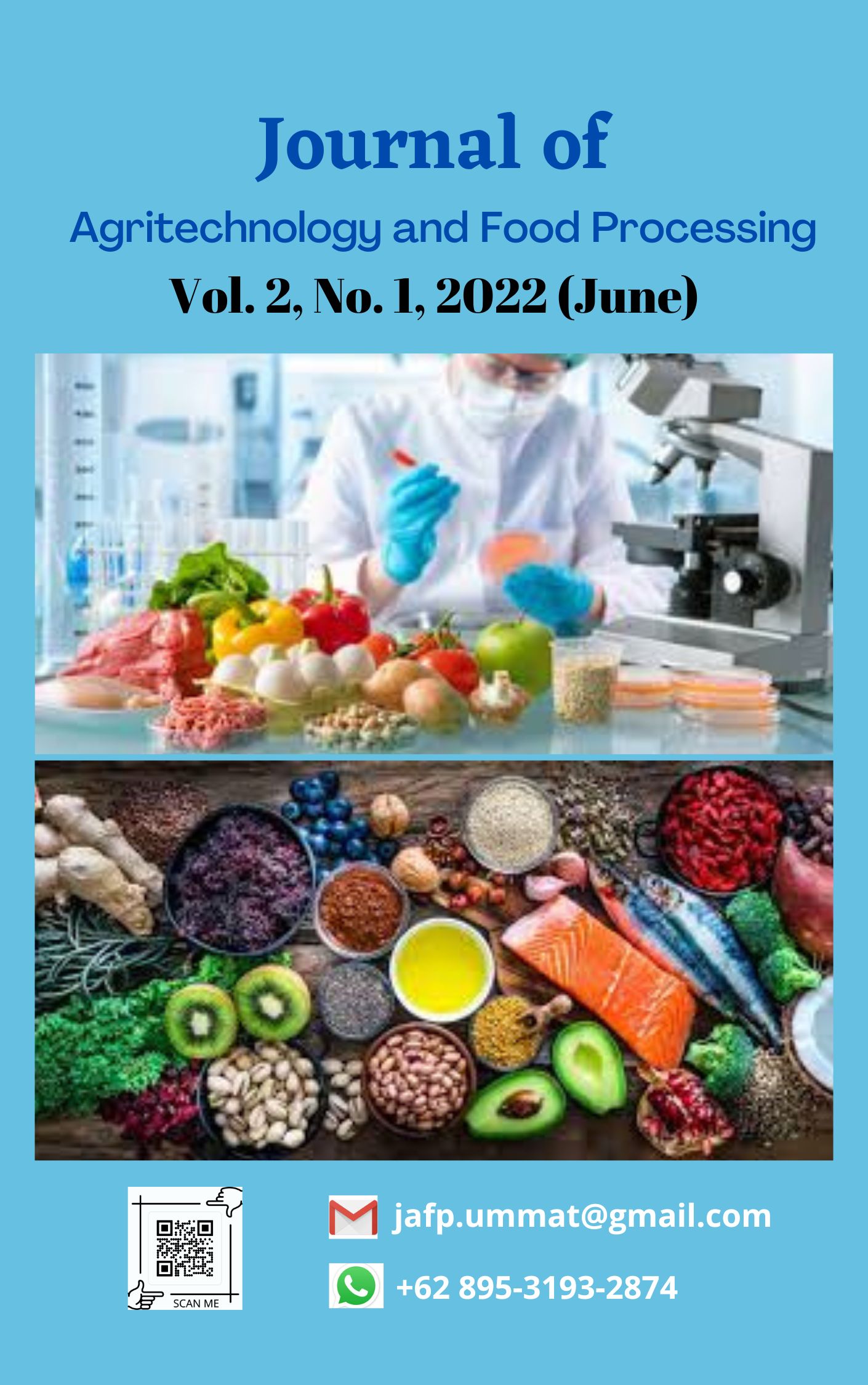Kajian penambahan serbuk pegagan (Centella asiatica) terhadap mutu cookies tepung mocaf (modified cassava flour)
DOI:
https://doi.org/10.31764/jafp.v2i1.6711Keywords:
cookies, pegagan powder, mocaf flourAbstract
Cookies are a type of biscuit made from wheat flour with a soft dough, high fat content, relatively crunchy, and dense texture. To increase the nutritional value and functional properties of cookies, it is necessary to add other ingredients such as pegagan plant. The pegagan plant contains chemical components that are good for human health such as calcium, ascorbic acid, and bioactive compounds such as triterpenoids and asiaticoside which have antioxidant activity. The purpose of this study was to determine the effect of the addition of pegagan powder on the quality of mocaf flour cookies and determine the percentage of addition of pegagan powder that was appropriate and preferred by the panelists. The method used in this study was an experimental method arranged in a completely randomized design with the addition of pegagan powder in the manufacture of cookies consisting of five treatments: P0 (100% mocaf flour/control), P1 (2.5% pegagan powder), P2 (5% pegagan powder), P3 (7.5% pegagan powder) and P4 (10% pegagan powder). The results of the measurement of chemical properties and organoleptic tests were analyzed using a further test of Honest Significant Difference at 5% level. Based on the results of the study, it was found that the addition of pegagan powder had a significant effect on all tested chemical properties (moisture content, ash content, vitamin C, and antioxidant activity) and also on taste, aroma, and color scores, but had no significant effect on cookies texture scores. In which, the higher the concentration of pegagan powder added, the water content, ash content, vitamin C content, and antioxidant activity increased, while the scores for aroma, taste and color tended to decrease. The best treatment favored by panelists was P3, with preferred taste, slightly favorable aroma, green appearance color, and slightly soft texture. The values of water content, ash content, vitamin C content, and P3 antioxidant activity were 8.36%; 3.08%; 0.38%; and 94.45%, respectively.
References
Annisa, F. (2019). Pengaruh Variasi Tepung Daun Kelor (Moringa Oleifera Terhadap Daya Terima Cookies Daun Kelor Pada Remaja Di Smp Perguruan Taman Siswa Cabang Lubuk Pakam. Politeknik Kesehatan Medan.
Ariyasa, I. K., Ina, P. T., & Arihantana, N. M. I. H. (2018). PENGARUH Perbandingan Tepung Kimpul (Xanthosoma Sagittifolium) Dan Pasta Daun Pegagan (Centella Asiatica) Terhadap Karakteristik Cookies. Jurnal Ilmu Dan Teknologi Pangan (ITEPA), 7(4), 223. https://doi.org/10.24843/itepa.2018.v07.i04.p09
Badan Standarisasi Nasional. (2011). SNI 01-2973-1992 (2011), Cookies.
Hermawati, R. Dewi, H. A. C. (2014). No Title. Fmedia (Imprint AgroMedia Pustaka).
Ihromi, S., Marianah, M., & Susandi, Y. A. (2018). Subsitusi Tepung Terigu Dengan Tepung Mocaf Dalam Pembuatan Kue Kering. Jurnal Agrotek UMMat, 5(1), 73. https://doi.org/10.31764/agrotek.v5i1.271
Imelda, S. dan E. D. (2015). Penambahan Pegagan (Centella Asiatica) Dengan Berbagai Konsentrasi Dan Pengaruhnya Terhadap Sifat Fisiko-Kimia Cookies Sagu. Jurnal Gizi Dan Pangan, 10(2). https://doi.org/10.25182/jgp.2015.10.2.%p
Intartia, N. (2017). Pengaruh penambahan serbuk pegagan (Centella asiatica (L) Urban) dengan konsentrasi yang berbeda terhadap sifat fisik, kimia, dan organoleptik crackers. Universitas Negeri Malang.
Kusnul, Z. (2020). Infeksi Covid-19 Dan Sistem Imun: Peran Pengobatan Herbal Berbasis Produk Alam Berkhasiat. Jurnal Ilmiah Pamenang, 2(2), 26–31. https://doi.org/10.53599/jip.v2i2.72
Meiry, A. D. (2019). Formulasi Permen Jelly Ekstrak Pegagan (Centella asiatica (L.) Urb.) dengan Variasi Basis Karagenan dan Konjak Untuk Peningkat Daya Ingat Anak. Jurnal FamilyEdu, Vol V No.1.
Miftah, N. A. (2014). Kadar Betakaroten Dan Organoleptik Minuman Daun Pegagan Hijau Instan Dengan Penambahan Konsentrasi Gula Pasir Yang Berbeda. Universitas Muhammadiyah Surakarta.
Putri, N. A., Herlina, H., & Subagio, A. (2018). Karakteristik Mocaf (Modified Cassava Flour) Berdasarkan Metode Penggilingan Dan Lama Fermentasi. Jurnal Agroteknologi, 12(01), 79. https://doi.org/10.19184/j-agt.v12i1.8252
Rahmawati, L., Asmawati, A., & Saputrayadi, A. (2020). Inovasi Pembuatan Cookies Kaya Gizi Dengan Proporsi Tepung Bekatul dan Tepung Kedelai. Jurnal Agrotek Ummat, 7(1), 30. https://doi.org/10.31764/agrotek.v7i1.1906
Saputri Imelda, D. E. (2015). Penambahan Pegagan (Centella asiatica) dengan Berbagai Konsentrasi dan Pengaruhnya TerhadapSifat Fisiko-Kimia Cookies Sagu. Jurnal Gizi Dan Pangan, 10(2), 149–156.
Sulistio, andian dwi. (2021). Pemanfaatan Daun Pegagan (Centella asiatica) menjadi Olahan Keripik. 5(2), 125–130.
Sutardi. (2016). Kandungan Bahan Aktif Tanaman Pegagan dan Khasiatnya untuk Meningkatkan Sistem Imun Tubuh Bioactive Compounds in Pegagan Plant and Its Use for Increasing Immune System. Jurnal Litbang Pertanian, 35(3), 121–130.
Downloads
Published
Issue
Section
License
Authors who publish with this journal agree to the following terms:
1. Authors retain copyright and grant the journal right of first publication with the work simultaneously licensed under a Creative Commons Attribution License that allows others to share the work with an acknowledgement of the work's authorship and initial publication in this journal.
2. Authors are able to enter into separate, additional contractual arrangements for the non-exclusive distribution of the journal's published version of the work (e.g., post it to an institutional repository or publish it in a book), with an acknowledgement of its initial publication in this journal.
3. Authors are permitted and encouraged to post their work online (e.g., in institutional repositories or on their website) prior to and during the submission process, as it can lead to productive exchanges, as well as earlier and greater citation of published work (See The Effect of Open Access).

